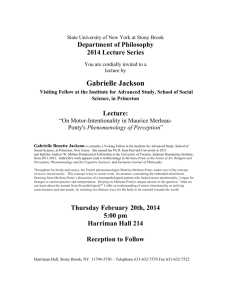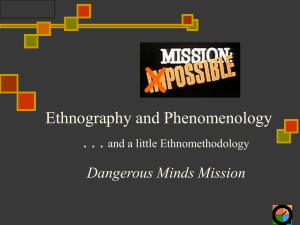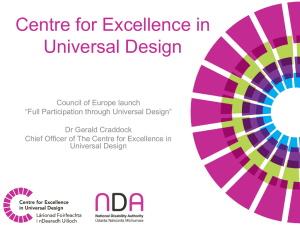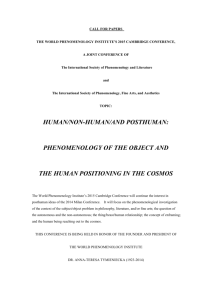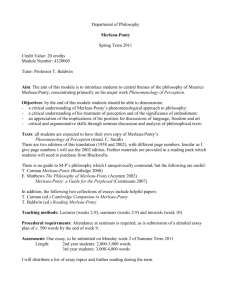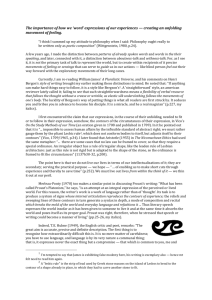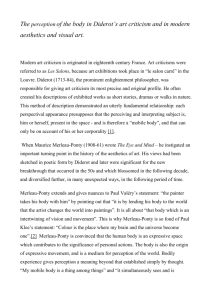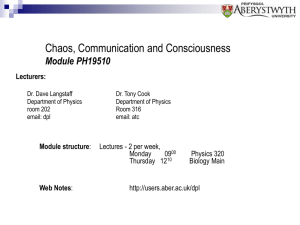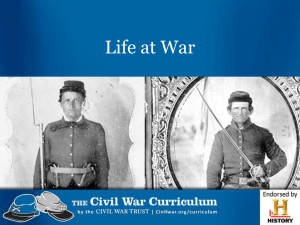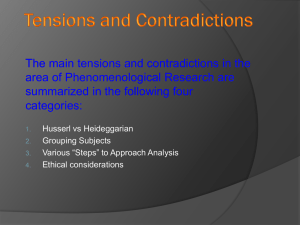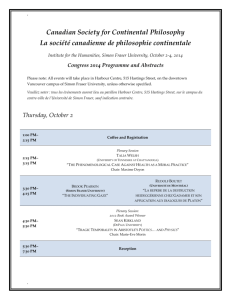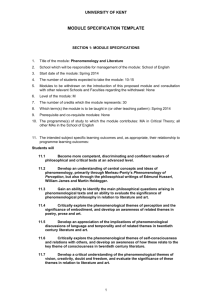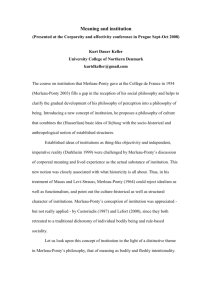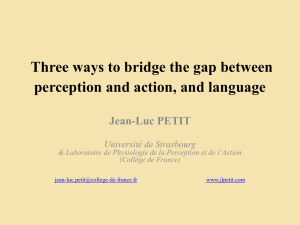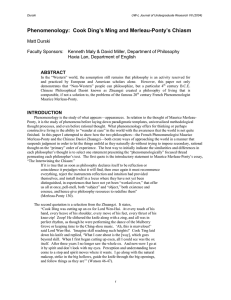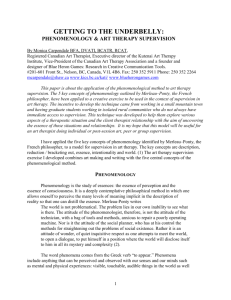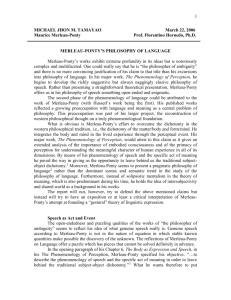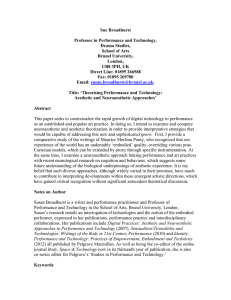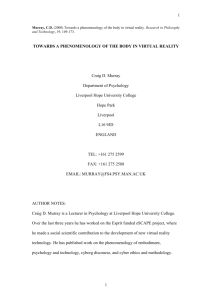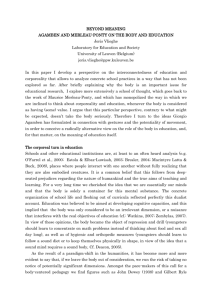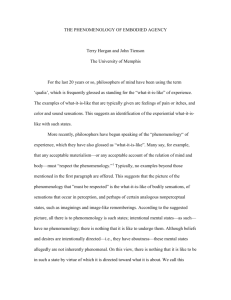View/Open
advertisement
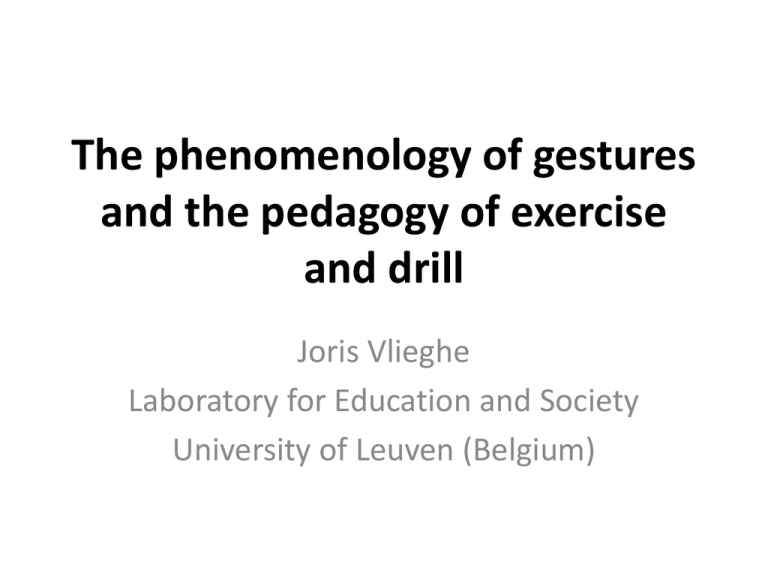
The phenomenology of gestures and the pedagogy of exercise and drill Joris Vlieghe Laboratory for Education and Society University of Leuven (Belgium) • General goal: to develop a new perspective on the role of corporeality for understanding educational phenomena (teaching and learning) • The perspective I develop could be called phenomenological • At the same time I criticize the main stream phenomenological approach to the issue of the body and education • I will focus on a specific pedagogical practice: exercise/drill (German: ‘Üben’; Dutch: ‘oefenen’) Overview (1) Mainstream view : phenomenology of the meaning-generating body (Merleau-Ponty) and its succcesses in pedagogy (2) Critique of this mainstream view (3) Alternative approach: phenomenology of gestures (Vilém Flusser) Mainstream view • This view should be understood as a reaction to firmly rooted prejudices in educational theory and practice regarding the body, viz. intellectualist and dualist accounts These accounts regard corporeality - either as a nuissance/danger - or as a dimension that has at most a secondary relevance • Although in practice these prejudices are still far too prevalent, in theory intellectualist/dualist accounts have lost lot of their cedibility As a result of: - societal and cultural evolutions - scientific discoveries (e.g. mirror neurons) - input from philosophy (Dewey, Ryle, MERLEAU-PONTY) Mainstream view • Merleau-Ponty shows that [1] what is so called ‘intellectual‘ is in reality dependent upon the way in which we are as bodies situated in the world [2] many things we learn are in reality no cognitive, but practically embodied skills [3] the body itself is a source and carrier of meaning (it has its own intentionality) Mainstream view • In the wake of these insights, many educationalists have argued for a more body-centered pedagogy: it is high time to recognize that the body is a neglected resource we should put at work in order establish relevant educational goals, more efficiently and/or in a way that is more respectful to the whole human being • E.g.: testing knowledge of scientific concepts; dealing with xenophobia; physical litteracy; laughter • At the same time: a plea to abolish obsolete practices like exercising and drill (which merely discipline and subject the body) in favour of practices that appeal to the meaning-creative potentials inherent to the body Critique of the mainstream view • Three fundamental lines of criticism (I will only deal with the first two in this presentation) : [1] the body is actually turned into an instrument for obtaining goals that have nothing to do with the body [2] the body is taken seriously indeed, but only insofar it can do the same things that used to be reserved to the solemn realm of the mind (intentionality, meaningcreation): body = mind in disguise [3] this theoretical reappraisal of the body doesn’t convincingly explain why in practice there has been (and still is) such a hostility vis-à-vis the body in education An alternative approach • A view which takes the idea far more seriously that education is a corporeal affair • I turn to the work of Vilém Flusser (1920-1991), an author who is not often discussed and who focussed his attention among other things on new media – and more specifically on the differences between writing and digital forms of communication Does Writing Have a Future? (2011) Into the Universe of Technical Images (2011) • Attempt to develop ‘a phenomenology of gestures’ Phenomenology of ‘gestures’ Gestures are … • embodied practices, often related to concrete material objects/tools, • the sense of which should NOT be understood in view of an already given idea about this practice from a mind-focused perspective (i.e. what we spontaneously think and feel when we perform a certain activity) • BUT, the sense of which should be understood from material-technological dispositions that constitute this practice Phenomenology of ‘gestures’ • For example: the gesture of writing “what does it means to put very material letters upon the surface of a very material sheet of paper?” • We should NOT approach it in the first place as a medium (instrument) for expressing meaning • BUT as an activity that follows a specific logic of its own, and which shapes our potential to express meaning in the first place • Difference between ideographic/numerical ‘writing’ and alphabetic writing: whilst alphabetic writing is linked to the one-dimensional logic of the ear, numerical/ideographic writing mirrors the twodimensional logic of the eye • As such different forms of writing correspond to different ways of thinking: alphabetization as a precondition for the possibility to think in a manner that is rational, causal and historical (Cf. McLuhan, Ong, Stiegler) • Flusser's interest in this evolution stems from his concern what a shift towards digital literacy would imply (gesturologically spoken it concerns a completely different way to relate the world, implying a fundamental transformation in our selfexperience) • Rather than exploring further what the (near) future might bring, I'll focus on the more 'traditional' practice of alphabetization, i.e. learning writen languge by repeating (collectively and repetitively) the basic elements of this language (a, b, c, ...) • mostly this is seen as an obsolete practice or as something that has no intrinsically educational value (merely a preparation for the truly meaningful activities) (cf. Merleau-Ponty) • However, taking Flusser's point of view seriously, it might be argued that this kind of exercise/drill constitutes the essence of (school) education • The obsession with meaning (Merleau-Ponty) precludes the possibility to come to terms with the role of corporeal dimensions of education that are precisely disposed of meaning • Seen as gesture, repetitive and collective exercise are heavily embodied practices that imply a very specific (and unusual) way to relate to a subject matter (here: written language). • The basic idea then is that these corporeal dimensions do matter: learning alone or together, with or without repetition makes a difference. • Exercise and drill make us relate to the basic dimensions of a subject matter, NOT as individuals with our own interests and motivation, BUT as a collective of bodies. • Precisely this can account for the educational significance of exercise/drill : their specific ‘gestural’ quality grants the possibility of real transformation, i.e. a suspension of the usual way in which our individual and collective lives are ordered • This kind of analysis can be used to elucidate the sense of all kinds of school practices (learning to count, declination of verbs, basic callisthenics, singing in group, etc.)
